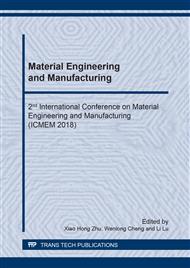[1]
J. Ptacek, G. Devgan, G. Michaud, H. Zhu, X. Zhu, J. Fasolo, H. Guo, G. Jona, A.Bretkreutz, R. Sopko, R.R. McCartney, M.C. Schmidt, N. Rachidi, S.J. Lee, A.S. Mah, L. Meng, M.J.R. Stark, D. Stern, C.D. Virgilio, M. Tyers, B. Andrews, M.Gerstein, B. Schweitzer, P.F. Predki, M. Snyder, Global analysis of proteinphosphorylation in yeast, Nature 438 (2005).
DOI: 10.1038/nature04187
Google Scholar
[2]
S. Morandell, T. Stasyk, K. Grosstessner-Hain, E. Roitinger, K. Mechtler, G.K. Bonn, L.A. Huber, Phosphoproteomics strategies for the functional analysis of signal transduction, Proteomics 6 (2006) 4047–4056.
DOI: 10.1002/pmic.200600058
Google Scholar
[3]
K. Schmelzle, F.M. White, Phosphoproteomic approaches to elucidate cellular signaling networks, Curr. Opin. Biotechnol. 17 (2006) 406–414.
DOI: 10.1016/j.copbio.2006.06.004
Google Scholar
[4]
T.E. Thingholm, O.N. Jensen, M.R. Larsen, Analytical strategies for phosphoproteomics, Proteomics 9 (2009) 1451–1468.
DOI: 10.1002/pmic.200800454
Google Scholar
[5]
Ficarro, S. B., et al. Phosphoproteome analysis by mass spectrometry and its application to Saccharomyces cerevisiae. Nature Biotechnology20 (2002) 301-5.
Google Scholar
[6]
J.D. Dunn, G.E. Reid, M.L. Bruening, Techniques for phosphopeptide enrichment prior to analysis by mass spectrometry, Mass Spectrom. Rev. 29 (2010) 29–54.
DOI: 10.1002/mas.20219
Google Scholar
[7]
Nühse, Thomas S., et al. Large-scale Analysis of in Vivo Phosphorylated Membrane Proteins by Immobilized Metal Ion Affinity Chromatography and Mass Spectrometry. Molecular & Cellular Proteomics 2 (2003) 1234-1243.
DOI: 10.1074/mcp.t300006-mcp200
Google Scholar
[8]
Yang D. S., Ding X. Y., Min H. P., et al. Design and synthesis of an immobilized metal affinity chromatography and metal oxide affinity chromatography hybrid material for improved phosphopeptide enrichment. Journal of Chromatography A, 7 (2017).
DOI: 10.1016/j.chroma.2017.05.025
Google Scholar
[9]
Alpert, A.J.,O. Hudecz, and K. Mechtler. Anion-exchange chromatography of phosphopeptides: weak anion exchange versus strong anion exchange and anion-exchange chromatography versus electrostatic repulsion-hydrophilic interaction chromatography. Analytical Chemistry. 87 (2015).
DOI: 10.1021/ac504420c
Google Scholar
[10]
C.L. Nilsson, Advances in quantitative phosphoproteomics, Anal. Chem. 84 (2012) 735–746.
Google Scholar
[11]
Nonglaton, G, et al. New approach to oligonucleotide microarrays using zirconium phosphonate-modified surfaces.Journal of the American Chemical Society. 126 (2004) 1497-502.
DOI: 10.1021/ja039072r
Google Scholar
[12]
Zhou, H., et al. Specific phosphopeptide enrichment with immobilized titanium ion affinity chromatography adsorbent for phosphoproteome analysis. Journal of Proteome Research. 7 (2008) 3957.
DOI: 10.1021/pr800223m
Google Scholar
[13]
Wijeratne A B, Wijesundera D N, Paulose M, et al. Phosphopeptide Separation Using Radially Aligned Titania Nanotubes on Titanium Wire [J]. ACS Applied Materials & Interfaces, 2015, 7(21): 11155-11164.
DOI: 10.1021/acsami.5b00799
Google Scholar
[14]
Zhang Y, Li J, Niu F, et al. Comparison of a novel TiO2/diatomite composite and pure TiO2 for the purification of phosvitin phosphopeptides [J]. Journal of Chromatography B, 2014, 960: 52-58.
DOI: 10.1016/j.jchromb.2014.03.038
Google Scholar
[15]
Huang X, Wang J, Liu C, et al. A novel rGR-TiO2-ZrO2 composite nanosheet for capturing phosphopeptides from biosamples [J]. Journal of Materials Chemistry B, 2015, 3(12): 2505-2515.
DOI: 10.1039/c4tb01899k
Google Scholar
[16]
Li X S, Chen X, Sun H, et al. Perovskite for the highly selective enrichment of phosphopeptides [J]. Journal of Chromatography A, 2015, 1376: 143-148.
DOI: 10.1016/j.chroma.2014.12.036
Google Scholar
[17]
Larsen M R, Thingholm T E, Jensen O N, et al. Highly selective enrichment of phosphorylated peptides from peptide mixtures using titanium dioxide microcolumns [J]. Molecular & Cellular Proteomics, 2005, 4(7): 873-886.
DOI: 10.1074/mcp.t500007-mcp200
Google Scholar
[18]
Deng Z, Dong M, Yan W, et al. A biphasic affinity chromatographic approach for deep tyrosine phosphoproteome analysis [J]. Analytical Chemistry, 2017, 89(4): 2405-2410.
DOI: 10.1021/acs.analchem.6b04288
Google Scholar
[19]
Q. Zhang, N Tang, J, Brock, Enrichment and analysis of nonenzymatically glycated peptides: Boronate affinity chromatography coupled with electron-transfer dissociation mass spectrometry, Journal of Proteome Research 6 (2007) 2323-2330.
DOI: 10.1021/pr070112q.s001
Google Scholar
[20]
E.S. Gil, S.M. Hudson, Stimuli-reponsive polymers and their bioconjugates, Progress in Polymer Science. 29 (2004) 1173-1222.
DOI: 10.1016/j.progpolymsci.2004.08.003
Google Scholar
[21]
H. Kanazawa, T. Okano, Temperature-responsive chromatography for the separation of biomolecules, Journal of Chromatography A. 1218 (2011) 8738-8744.
DOI: 10.1016/j.chroma.2011.04.015
Google Scholar
[22]
Gil, Eun Seok, and S. M. Hudson. Stimuli-reponsive polymers and their bioconjugates., Progress in Polymer Science. 29 (2004) 1173-1222.
DOI: 10.1016/j.progpolymsci.2004.08.003
Google Scholar
[23]
R.J. Dai, C. Lei, Z. Liu, Preparation and characterization of temperature-responsive chromatographic column containing poly(N-isopropylacrylamide) and poly([2-(methacryloyloxy)- ethyl]trimetylammonium chloride), Journal of Applied Polymer Science. 121 (2011).
DOI: 10.1002/app.33830
Google Scholar
[24]
Y.Y. Shen, L.L. Dong, Y.L. Liang, Z.J. Liu, R.J. Dai, W.W. Meng, Y.L. Deng, Effect of the grafting ratio of poly(N-isopropylacrylamide) on thermally responsive polymer brush surfaces, Journal of Separation Science. 40 (2016) 254-531.
DOI: 10.1002/jssc.201600890
Google Scholar


